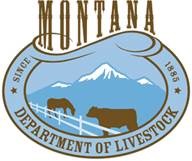Montana Rancher Q and A: Rose Malisani, Cascade

Rose Malisani on her horse near Cascade, MT.
Rose Malisani and her mother, Cindy, ranch near Cascade Montana. Rose not only helps on the family ranch, but she also is the MSU Cascade County Ag Extension agent, where she gets to help youth and local ranchers learn more about their livestock and land. If you haven’t met Rose, when you do, you will immediately have a smile on your face…she has the wonderful ability to make people laugh and feel happy. Read more about Rose and her family on today’s blog:
How long has your family been involved in ranching?
My family has been involved in agriculture for four generations. My maternal great-grandfather was a cattle and sheep buyer. He started in Windham, MT and eventually moved his family to the ranch in Cascade, MT. My maternal grandmother’s family farmed out of Geraldine, MT. Both my paternal grandparents were born in Italy and moved to the United States in the early 1900s. They started a very successful tile and terrazzo family business that is currently operated by my cousins. My dad decided to sell the family business to my uncle in the late 1970s and began ranching. My mom has some great stories of teaching the city guy how to ranch!
What was your favorite part about growing up on the ranch?
Working with my brother, Jack. He took me under his wing and taught me how to operate the tractors, fence, cuss, work with cattle, and so much more. Those were short, sweet years.
Tell us about your ranch today.
We’ve run a bred heifer operation for the last 15 years where we sell quality commercial Angus heifers to ranchers. We started running cows again in the past year and it’s fun to see calves back on the place. We also breed and ride AQHA horses. Our horses over the years have gone into the rodeo, show, ranching, jumping, and movie worlds in the United States and Canada.
What have been some of the trials you’ve had to overcome?
Life is about how you react to change. One needs to know how to roll with the punches and adjust. Sometimes a surprising change works out splendidly.
What is one thing you wish more people knew about life on the ranch?
The beauty of it. Being able to get to swing your leg over a good horse and gather cattle in the mountains is my idea of heaven. Farmers and ranchers work so hard every day to feed their family and other people’s families.
What does it mean to you to be able to work with your family every day?
The stories of days gone by. My grandparents and mom tell about when they grew up on the ranch and their dreams for the future. I wouldn’t change it for the world.
Is there anything you would have done differently on the ranch if given the chance?
I would have to say no. I’m a firm believer on not living with regrets and when change is needed, do it. Tell us about your current job and why you are excited to be a part of agriculture in that capacity. Besides working on the ranch I am the MSU Cascade County Ag Extension agent based out of Great Falls, MT. My job is extremely exciting that some days I don’t know if I will be helping a gardener with their tomatoes, inspecting a wheat field for disease, traveling for a training, helping a rancher with nitrate tests or working with 4-H members with their horse and livestock projects. The beauty of my job is to see people and talk about my favorite topic, agriculture. I started off working for the Montana Beef Council and then the Montana Stockgrowers Association out of college and I cannot express how blessed I am to have worked Montana ranchers.
Do you have any advice for future Montana rancher generations about running a successful beef cattle business?
Open communication with family members and partners. Develop a plan and put goals in place. Partner meetings are extremely important.
What’s your favorite beef dish?
A rare steak off the grill. Can’t beat it!
Is there anything else you can share with us?
Do good work in everything you do. Be honest and helpful.


























